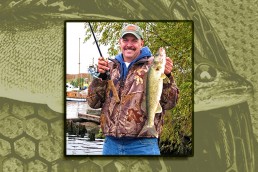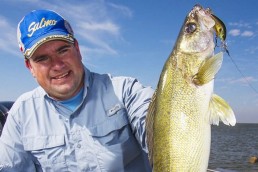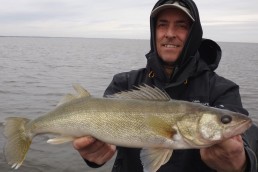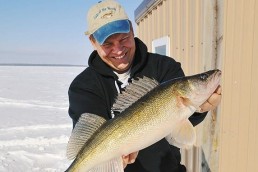Unpressured Winter Walleyes are There for the Catching
SHARE THIS POST
Veteran walleye anglers love to bundle up in warm clothing and go fishing while most are watching television. Through the winter, I’m able to find catchable walleyes on the Missouri waters of Smithville, Truman, and Table Rock lakes. The taste of fresh walleye fillets from cold water is remarkable, and it’s a big part of what I’m after. The trick is knowing where to look.
Winter walleyes are structure-oriented and often hungry. Look for angled bottom structure that eventually meets a drop-off. I especially like rocky shelves or huge boulders. Then I drift across these areas with minnows–or salted minnows where live bait is not permitted. Walleyes suspend in these areas in search of baitfish.
I constantly keep the motor running to stay on fish in windy conditions. Wind will often push you past productive waters and winter fish are often staged on slanted areas. A few feet to the right or left can mean no strikes. The key is staying where the walleyes want to be. I use 1/4-ounce jig heads in calm water and 3/8-ounce or heavier in wind and waves. We change sizes until the best size is found.
Most winter walleyes hold tight to the bottom. A soft occasional lift off the bottom can draw many strikes. Sometimes hits come on the drop, making line control extremely important. Other times hits may be soft, no more than a light twitch or the line might suddenly start moving sideways.
Vertical fishing
Start by moving to likely spots around rocks or weed beds and fish vertically. Minnows or nightcrawlers are dropped straight down and either suspended or brought up a reel turn every five minutes. The idea is to let that walleye study your bait by hanging it in front of the fish’s nose.
Try using bright gold or blood-red hooks for added attraction. We like to add a tiny piece of Christmas tree tinsel for more shine. Some even glue glitter to their hook or bait. Keep in mind that walleyes can detect strange odors, so use glue with the least odor.
Casting
Many anglers cast for winter walleyes. I like to use a much smaller jig or lure during the coldest weather. We have caught many fine walleyes while fishing for winter crappies with 1/80- or 1/100-ounce jigs tipped with maggots or a commercial brand of crappie additive.
Again, use a slow retrieve while making sure you keep each offering on the bottom. Twitch your rod tip on occasion. Sometimes this added move will draw strikes. The key is placing your bait in front of the walleye’s face, a feat accomplished by patience and lots of time in uncomfortable weather conditions. The couch and a football game are warmer, but not nearly as satisfying as catching a 6-pound walleye on 4-pound-test line.
Are you enjoying this post?
You can be among the first to get the latest info on where to go, what to use and how to use it!
Live baits
Minnows, leeches and nightcrawlers are extremely effective for walleyes. Hook your leeches toward the end so they can wiggle and flop. Nightcrawlers are more effective with a shot of air with a hypodermic needle so they float off the bottom better. Minnows, especially salted versions, can be hooked through the mouth, extending the hook out and up through the minnow’s back.
Trolling
Trolling is an excellent winter technique if you go slow enough. I like to use the current for trolling or bumping baits, lures or jigs across the bottom. I simply turn my boat sideways and cast out two or three lines. Make sure your baits, jigs or lures are weighted well enough to stay on the bottom. Then watch each rod. Walleyes often hook themselves because of this little motion.
Try trolling floating lures, like Bombers and Smithwick Super Rogues. Firetiger, chrome-black, and chrome-blue are my favorite color patterns. Use plenty of weight, about a foot up from the lure, to hold each presentation on the bottom.
Pay close attention while making S-turns when trolling. Bites seem to come on the turn, no matter if it is on the inside or outside turn, when I let my rod sweep back to allow slack line. The Bomber Long A, Rogue, or other floating baits will float up slightly, often triggering bites.
Despite the cold temperatures and lowered pace of life for walleyes, winter is an excellent (and overlooked) time to go after these challenging and great-eating fish. Bundle up, slow down your presentation, and the rewards are worth the effort.
Kenneth L. Kieser is an award-winning writer of 38-plus years who is a member of the National Fresh Water Fishing Hall of Fame and Waterfowlers Hall of Fame as a Legendary Communicator. Also named 2014 Conservation Communicator of the Year by Missouri Conservation Federation, we are excited to welcome his voice to MidWest Outdoors.
MWO
SHARE THIS POST
Did you enjoy this post?
You can be among the first to get the latest info on where to go, what to use and how to use it!
Kenneth L. Kieser
Kenneth L. Kieser is an award-winning writer of 38-plus years who is a member of the National Fresh Water Fishing Hall of Fame and Waterfowler’s Hall of Fame as a Legendary Communicator. Also named 2014 Conservation Communicator of the Year by Missouri Conservation Federation, we are excited to welcome his voice to MidWest Outdoors.



